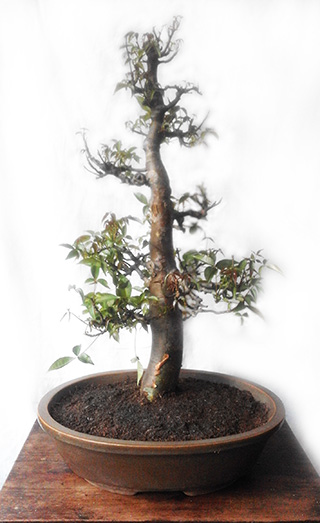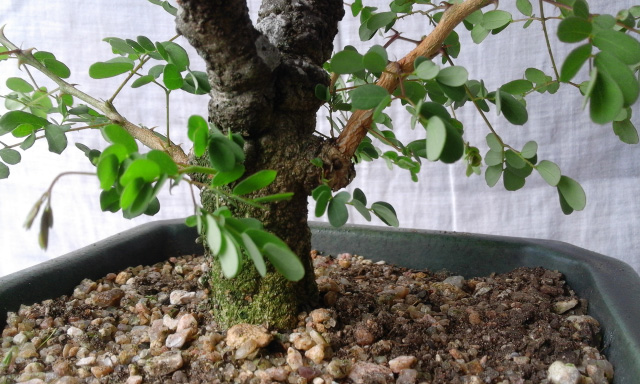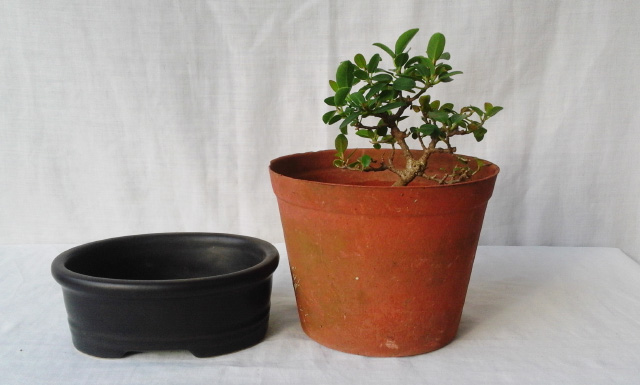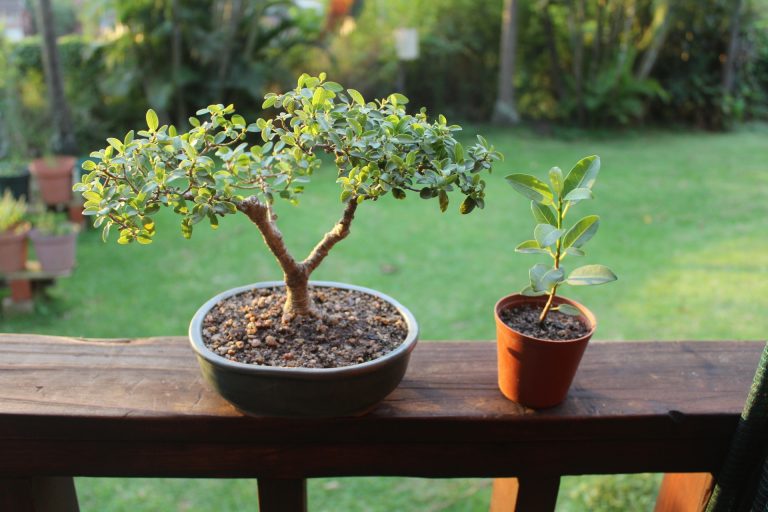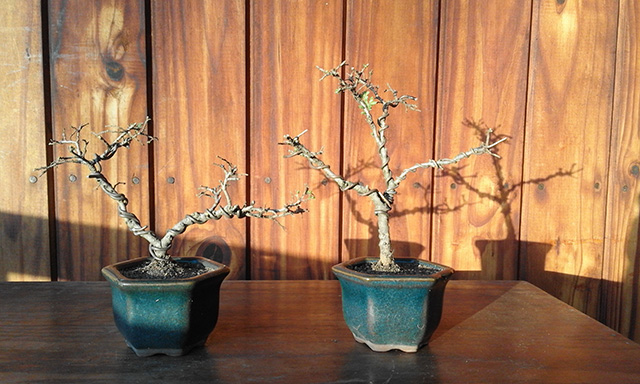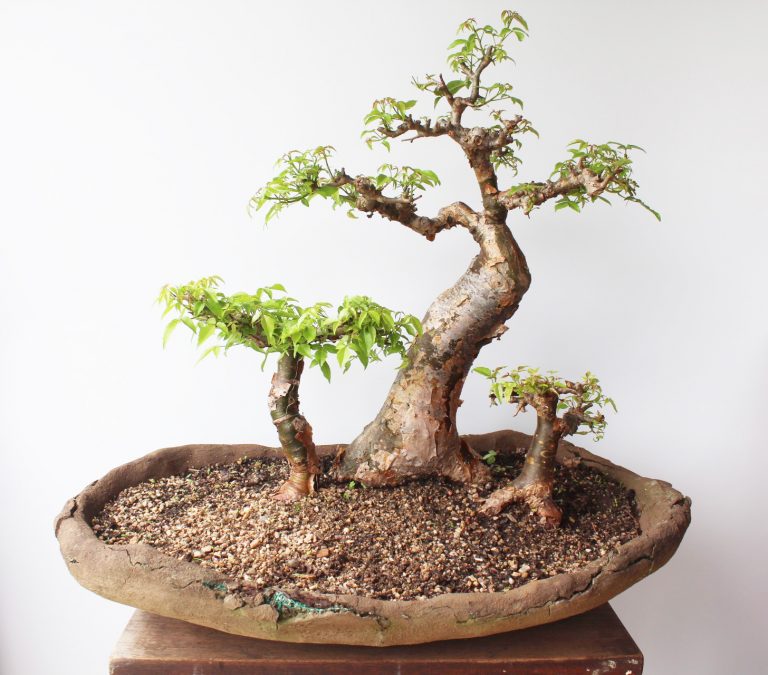Adventures in Bonsai Re-potting – The Sequel
Re-potting an informal upright Commiphora Harveyi bonsai
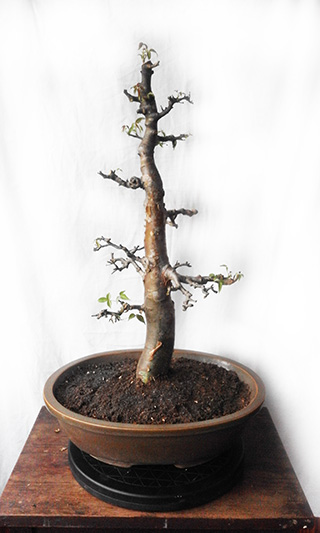
In this tutorial I am re-potting a Commiphora Harveyi bonsai that I dug out of the bush almost twenty years ago. It has been sitting in the same pot for all that time just waiting for today. Why has it taken me so long to get around to re-potting it? Well, life gets in the way sometimes. But, that is the thing with bonsai. While we are caught up in our chaotic everyday lives, our trees just keep on doing what they do, grow. This tree has developed well over the years and now deserves to be placed in a nice display pot.
Commiphora Harveyi
Commiphora are part of the myrrh (pronounced murr) family of plants, which was one of the three gifts the wise men gave baby Jesus. The myrrh family are a group of very fragrant plants from which perfumes and aromatic incenses were made. The Harveyi sub-species are indigenous to South Africa, and they make wonderful bonsai. In Afrikaans the plant is known as the Kan-Nie-Dood-Nie, which translated roughly into English means Can’t-Be-Killed. This is not entirely true, but it is a very robust plant, and generally grows really well from cuttings. Farmers in Zululand often use thicker branches of this tree to make walls around their cattle kraals. The branches often take root without any additional encouragement, resulting in very strong and efficient hedges.
Commiphora Harveyi make wonderful bonsai material
Apart from their will to grow, and their ability to grow from cuttings, there are a couple of other aspects to commies that make them good bonsai material. They don’t have thorns! Thorn trees present a specific challenge to bonsai growers because a lot of the final refining of a tree is done using one’s fingers. Nipping the buds of a thorn tree is a painstaking process, but nipping the leaves and buds of commihora harveyi is an absolute pleasure. Because it is an aromatic tree, as the buds are nipped, the tree exudes a most beautiful fragrance. One’s fingertips become lightly coated in the juice and it is almost a shame to wash one’s hands afterwards.
Leaf size reduction
Commiphora harveyi has quite large leaves, but they do reduce down to about half their size. The leaves will never become tiny, so this species of tree is better suited for medium to large bonsai, however, the leaf pads can become quite dense, enabling one to produce a really convincing miniature tree. As always, after re-potting, the first set of leaves will be large, and will remain large for a year or two. The plant will be in a vegetative growth phase, meaning that both the roots and the leaves will be growing vigorously to recover from the pruning of both the roots and the branches. After a couple of seasons the tree will stabilize, move into a mature phase, and the leaves will begin to reduce in size once again.
The Re-potting Process
The re-potting process is fairly straight forward. First prepare the pot. Clean it. Put some gauze or mosquito netting in the bottom to prevent the soil from running out through the drainage holes, and half fill with bonsai soil. Do all of this before you remove the tree from its old pot, in order to reduce the amount of time the roots are exposed to the air. Prune the roots to a length and shape that will allow the tree to stand comfortably in the pot. Remove any large roots, and in particular those that grow straight down. A good root system spreads out laterally from the base like the spokes of a bicycle wheel.
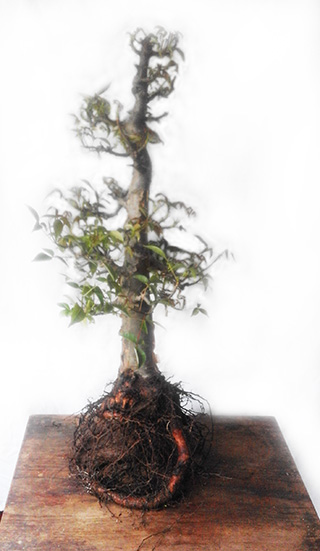
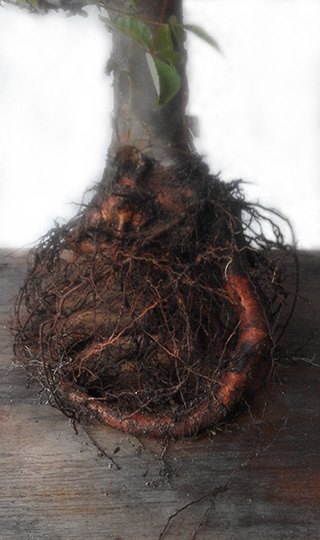
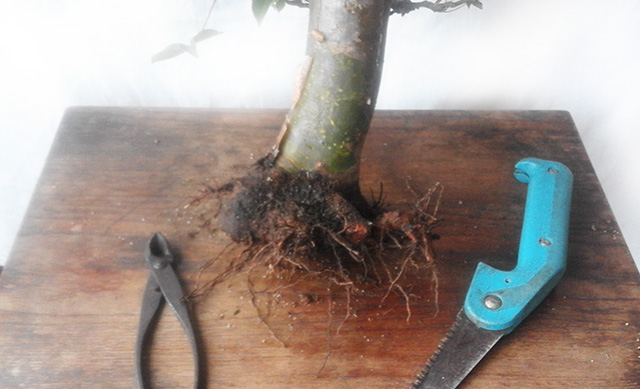
I also do any major branch work, removing a large branch, or heavy-duty wirework, while the tree is out of the soil. This is simply because the tree is much lighter without the pot and soil. This makes it easier to get to awkward places and there is less chance of damaging the tree. In this case there is no need for any major branch work, so I placed the plant in the pot first, and did the final branch and leaf work at the end.
Bonsai Re-potting and Mycorrhiza
After removing the tree from its old pot, I took a couple of handfuls of the old soil and mixed it in with the new soil. This is because the old soil has mycorrhiza. No, mycorrhiza is not some kind of weird disease. The term mychorrhiza refers to the symbiotic relationship between the roots of a tree, and fungus or microbes, in the soil. These microbes assist the roots to absorb and process nutrients in the soil. The fungus is produced by the tree itself over a period of time and it becomes a vital element in the soil or biosphere around a tree’s roots. The root system of trees is technically called the rhizosphere.
Almost all plants produce mycorrhiza, but modern trees, modern meaning those that evolved quite recently in the scheme of evolution, have the ability to produce mycorrhiza quickly. They are not so reliant on old soil being mixed in with the new. Primitive trees like pines and junipers must have some old soil mixed in to enable the plant to recover. When I re-pot trees I almost always mix in some old soil regardless of what species I am working with just to give the newly re-potted tree every possible chance of survival.
Conclusion
This particular tree is not a “perfect” tree. It has some design “flaws”. Note that I put these two words in quotes. Bonsai is an art form, an expression of creativity and emotion. Words like perfect, flaws, right or wrong, have no real place in art. Even though we hold bonsai exhibitions where one or two trees receive awards for excellence above others, bonsai IS NOT A COMPETITION! We follow styling guidelines not because they are “right”, but because, over the course of a few thousand years, we have learnt what looks more pleasing to the viewer. Quite often the aspects that we might call flaws are the very aspects that make a particular tree special.
This tree has some issues that I would like to change if I had Harry Potter’s magic wand. There are a few too many branches at a point about one-third up the trunk from the ground. Conventionally, a tall upright tree like this would have the bottom third of the trunk bare of branches. At the one-third point there would be one predominant side branch. A bit further up the trunk the second side branch should emerge on the opposite side of the tree. The second side branch should be slightly smaller and less dominant than the first side branch. The side and back branches get smaller as they progress up the trunk, alternating sides as they progress. My tree has four side branches all at a similar point one-third up. There were more of them but I removed a few. I am not sure right now if I should remove more to adhere to convention, so I am going to just leave them alone for the moment and make that decision at some point in the future.
There is also one branch in particular half way up that is growing at a very obvious 45 degree angle. I could wrap some wire around it and try and bend it down a bit, but when I tested it the branch was a bit stiff. It might break if I tried to bend it. I think I might just leave it as it is. It may be one of those anomalies that improve the design rather than detract from it. I can always change it at a later point as well. No hurry, this IS bonsai after all.
